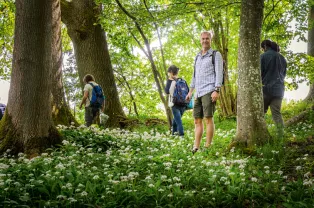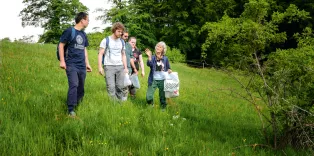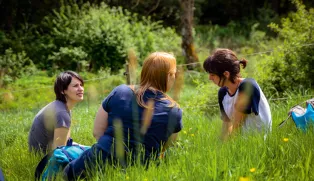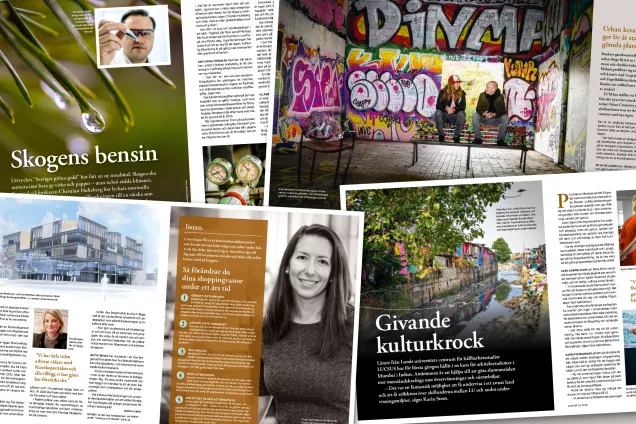It starts with a warning.
“Here we have lily of the valley, it’s poisonous. And here we have wild garlic, this you can eat”, says Honor C Prentice, professor at the Department of Biology, while holding two seemingly identical bouquets.
“Smell, you will notice the difference.”
Once their noses are content, the group wanders off. Most of them with their trouser legs tucked into their socks to avoid ticks in the high grass. Some disappear down the hillside in search of the main ingredient for this evening’s nettle soup. Others pause a bit further up on the hill.
A short while later, the guides, Honor C Prentice and Torbjörn Tyler, have had time to pick and talk about about garden sorrel, field sorrel, ground elder, wild parsnip, mint and garlic root. Those who prefer listening to picking are also told that the occurrence of meadow saxifrage in the slope is a sign that the field was previously grazed and used to be less nutrient-rich than it is today.
“For great biodiversity, you want as few nutrients in the ground as possible”, explains Honor C Prentice.
Despite the fact that number of species is descreasing, there is still a sea of edible plants spreading out in the Abusa Valley. Doctoral students, postdocs, researchers and Master’s students have no problems filling their bags and baskets.
Elisa Rigosi is bending over a cluster of nettles.
“I’m making a frittata tonight. I’m going to put nettles in it.”
Helena Fritz, meanwhile, is focusing on wild garlic. Last year, she tried to make wild garlic salt but it didn’t go so well. Neither did her attempt to pickle wild garlic buds.
“I screwed up. I will try again this year.”
Iryna Semashko has inherited her interest in herbs. There’s no denying her enthusiasm when she takes out a botanical dictionary in Ukrainian.
“My father is very interested in herbs and herbal medicine. So am I.”
The cultural and historical differences between countries become apparent when Wang Yutao tells about his parents living in the Chinese countryside. Only 40 years ago, they had to pick whatever nature had to offer to survive and support the family.
In Sweden, people viewed wild herbs and plants differently. The focus has been on cultivation.
“In 19th century Sweden, famine could probably have partly been avoided if people had gathered more from nature”, says Torbjörn Tyler.
These days, there is a different interest in wild herbs, and luxury restaurants pay a lot of money for naturally grown fresh herbs.
“I have a friend who makes a living from picking herbs”, says Torbjörn Tyler.
For Johan Hollander who organised the herbal excursion, the image of a Greek horta – a salad composed of the first wild vegetables of spring – is what comes to mind when describing the day.
“It’s like eating spring.”
JAN OLSSON
FACTS:
SACT promotes integration
The herbal excursion was organised by SACT (Scientific ACTivities), a group within the Department of Biology, aimed at promoting integration among staff. The group organises a wide variety of social activities, including bird watching, museum tours, herbal excursions and seminars. SACT was formed in 2010 when five departments merged into the Department of Biology.





